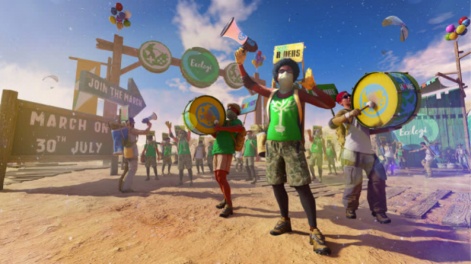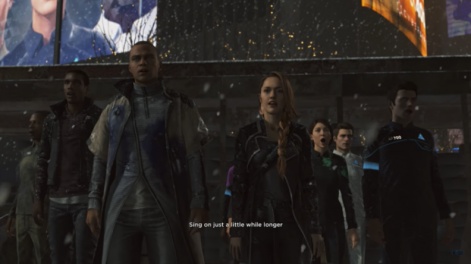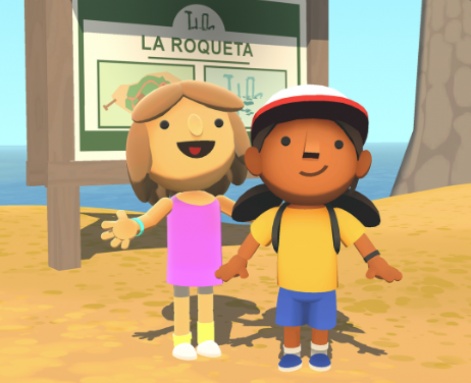As the world’s most popular - and interactive - medium, gaming has the unique potential among all art forms to inspire change among users, spreading positive change and (almost literally) putting us in someone else’s shoes, letting us see the world through their eyes or experiencing a world that we, as players, have the power to influence.
A key point of activism is an attempt to inspire positive change in the world, whether that’s by raising awareness of issues that should be addressed or lobbying for governments to act, whether that be on social issues or the climate issue.
Activism is often treated seriously, but it still has the potential for joyful expression. We’ve previously highlighted the work of game makers inspiring positive change through gameplay, but what if we thought of activism as a game?
Daniel Fernández Galeote is a researcher at the Gamification Group, Tampere University. He is a journalist, game designer and developer. His current research explores public engagement with climate change and sustainability through games and gamification. Here he discusses the gamification of activism, and the surprising commonalities between game design and the power to provoke positive change.
Introduction: Activism, joy, and game design
We may assume that for an activist to exist, all we need is a perceived mismatch between what is and what “ought to be.” Although activism is typically conceptualised as being all about purpose, a goal alone may not be sufficient for many of us to engage and, perhaps more importantly, to keep on struggling. Especially when goals feel far away and moments of victory are scattered, our energy can run low and commitment may falter. This is why it is good to have multiple drives for being engaged, one of which may be joy.
Although pleasure may seem too lighthearted when our collective survival is at stake, us humans long for joyful moments of interpersonal and more-than-human connection, freedom, and accomplishment. Fortunately, activism can deliver many of these feelings, as most of those involved can attest, without having to compromise the fact that system change is a serious endeavour. Then, questions arise: how does activism provide moments of joy that effectively attract prospective participants? How do we keep ourselves active in a way that feels right for us and avoid burning out once we are ready to give it all? Can game developers recognise and augment these moments of joyful experience?
Game makers represent a collective that knows how to keep people motivated to persist through challenging journeys, and to enjoy doing so. Designers typically envision the player’s experience and craft interactive systems suited to afford such experience, which more often than not includes forms of competence, autonomy, and relatedness. Through a few examples, I will illustrate how activism is more similar to games than we think, and how game professionals can contribute to designing activism in a way that supports long-lasting engagement. This is a task which activists have been working on for as long as social movements have existed.

The activism Game: explaining the game and the meta-game
Given the ideas expressed above, it may not come as a surprise that the fight for change already incorporates multiple concepts and principles that we find in games and gamification. I have divided my examples in this regard into two categories, one with the game itself at the core of activism, taking actions which directly seek to provoke change, and the meta-game, or the social systems and activities built around, and usually supporting, action.
First, how can we call direct action a game? Forms of protest have been interpreted through playful and performative lenses before. A good example is L.M. Bogad’s book Tactical Performance, which theoretically connects and practically reviews creative practices in activism, from the civil rights movement’s carefully crafted sit-ins to the Clandestine Insurgent Rebel Clown Army’s (CIRCA) antics. Crucially, these are as much about directly engaging non-activists - from passersby, both in favour and against, to the police - as they are about giving a performance for them to witness.
Based on these examples, there is much to be gained in understanding memorable protest as a fundamentally creative, narrative, and interactive activity. While the environmental movement is full of examples such as the Red Rebel Brigade, which brings life to artfully crafted costumes in its performative rituals, there is much to gain from involving game designers into the mix. After all, performative protest has been seen in games. For example, the developers of Detroit: Become Human gave players the option to oppose violence with music, and the classic Marc Eckō's Getting Up was all about exposing corruption through graffiti.

Behind this playful interpretation of protest, direct action offers multiple avenues for intrinsic need satisfaction, or those needs that when satisfied may lead to self-motivation and well-being. According to Ryan and Deci’s self-determination theory (SDT), these are competence, autonomy, and relatedness to others. While this is not the only theory attempting to explain human motivation, it is a quite useful one in this context. So, besides offering a serious purpose to fight for, can activism satisfy intrinsic needs? A quick glance shows that it can. To reinforce competence and autonomy, activism can make sure that everyone has a role fit for their skills, resources, and willingness to risk, from offering safe monetary contributions to facing legal repercussions, effectively crafting a challenge that the person feels capable of facing.
To satisfy relatedness, we can see that action is deeply rooted in support practices. For example, in the game Alba: A Wildlife Adventure, an environmental catastrophe can only be averted with the support and action of the whole community. Even in one-person protests designed for pandemic times, the activist is rarely alone, with support roles offering practical assistance and mental support before, during, and after actions. Furthermore, activists usually organise actions as affinity groups, or relatively small and semi-autonomous units within a movement where ideas and rituals can be shared with trusted colleagues. Concepts such as challenge, skills, player agency, and teamwork are likely familiar to most game designers, who craft experiences that take into account and promote these components.

As said above, direct action is only the tip of the iceberg of what being an activist means, and here we also find a direct parallel with games. In his 2011 book chapter “Reflections on Empirical Evidence on Games and Learning,” James Paul Gee discusses the difference between digital games as software, what he calls the “little ‘g’ game”, and the social interactions that players engage in within and around the game, or the meta-game. Together, these two form what he calls the “big ‘G’ Game.”
Applied to activism, it takes more than the action itself (the “little ‘g’ game”) to succeed. We need to consider the “big ‘G Game” - the social interaction that it inspires. Therefore, any understanding of activism as a Game will be incomplete without involving everything around it. The developers of the MMO Riders Republic understood this in their Rebirth event, where a virtual climate march and reforestation event combined collective joyful self-expression with a real tree planting campaign.
Planning and implementing a call for direct action in-game
Quests do not usually start when players arrive at a dungeon or any other sort of challenging arena. Rather, players typically prepare themselves by making plans, strategies, and acquiring resources. Direct action fundamentally works in the same way. Given this, game designers have a lot to say in how to support engaging preparation - after all, they only need to think of how communication, item and information acquisition, crafting, and other activities are supported in games. These insights may lend themselves to be incorporated in easier ways than is thought. With its typically democratic structures and voluntary ethos, activism is usually an activity undertaken freely, just as play often is; with its affinity and work groups, activists function through guilds and parties in the same way that MMO players do.
In fact, the experience of an activist begins much before it is time to prepare for an action. Is the starting point the moment when the person attends their first non-violent direct action (NVDA) training? Is it perhaps when they contact the organisation for the first time, when they first hear about the movement, or even maybe when they start asking themselves questions or feeling a concern? In any of these steps, designers and community managers can ensure that people feel supported all the way by contributing their knowledge and practice crafting tutorials as onboarding paths, progression systems, and playful experiences in and around games.
Finally, the meta-game also includes activities that can be crucial to the community without directly supporting protest. Well-being activities have been a way of staying connected and reinforcing community, in direct support of relatedness, through playful activities such as sports, board games, and hikes. Competence and autonomy can be exercised through prefiguration, or the forms in which we organise that reflect the changes we want - from urban gardening to cooperative forms of work and living. Understanding how people can live and satisfy needs in different ways can be inspirational and didactic experiences that game designers, as creators of alternative worlds, can bring about.

Conclusion: Game developers are at the avantgarde of a joyful present and future
Developers willing to see activism as a game, but especially as a Game, can be particularly useful as part of social movements seeking to engage people in the long term. It is not only that action should take into account people’s need for both competence and autonomy, as games often do. As Carla Bergman and Nick Montgomery remind us in their book Joyful Militancy (thanks to Candi Vieira, from the IGDA Climate SIG Discord, for the recommendation), “strong relationships are the foundation of resistance,” and game designers may know a thing or two about supporting strong relationships in the face of challenge. If we want a sustainable future where joy plays an important role, we better start already, for the game of activism offers plenty of opportunities for it.
If you are interested in joining fellow games folks in supporting local and international climate protests, campaigns and actions, stop by the Game Dev Rebellion channel in the IGDA Climate SIG Discord. To know more about Game Dev Rebellion, you can read the original post by Joost Vervoort.
Daniel Fernández Galeote is a researcher at the Gamification Group, Tampere University. In addition to doing science, he has professional experience as a journalist and as a game designer and developer. His current research explores public engagement with climate change and sustainability through games and gamification.
Edited by Lewis Rees























